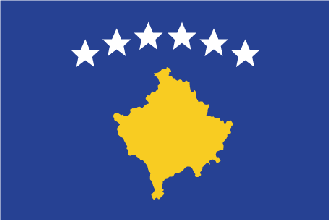
|
Kosovo
Background:
UN Security Council Resolution 1244 (1999) placed Kosovo under a transitional
administration, the UN Interim Administration Mission in Kosovo (UNMIK),
pending a determination of Kosovo's future status. A UN-led process began in
late 2005 to determine Kosovo's final status. The negotiations ran in stages
between 2006 and 2007, but ended without agreement between Belgrade and
Pristina. On 17 February 2008, the Kosovo Assembly declared Kosovo independent.
Since then, over 85 countries have recognized Kosovo, and it has joined the
International Monetary Fund and World Bank. Serbia continues to reject Kosovo's
independence and in October 2008, it sought an advisory opinion from the
International Court of Justice (ICJ) on the legality under international law of
Kosovo's declaration of independence.
Location:
Southeast Europe, between Serbia and Macedonia.
Area: 10,887 sq km.
Area - comparative: slightly larger than Delaware.
Land boundaries: total: 702 km.
border countries: Albania 112 km, Macedonia 159 km, Montenegro 79 km, Serbia.
352 km
Coastline: 0 km (landlocked).
Climate:
influenced by continental air masses resulting in relatively cold
winters with heavy snowfall and hot, dry summers and autumns; Mediterranean and
alpine influences create regional variation; maximum rainfall between October
and December.
Terrain:
flat fluvial basin with an elevation of 400-700 m above sea level
surrounded by several high mountain ranges with elevations of 2,000 to 2,500.
Natural resources: nickel, lead, zinc, magnesium, lignite, kaolin, chrome,
bauxite.
People:
Population: 1,836,529.
Ethnic groups: Albanians 92%, other (Serb, Bosniak, Gorani, Roma, Turk,
Ashkali, Egyptian) 8%.
Religions: Muslim, Serbian Orthodox, Roman Catholic.
Languages: Albanian (official), Serbian (official), Bosnian, Turkish, Roma.
Government:
Government type: republic.
Capital: Pristina (Prishtine, Prishtina.
Independence: 17 February 2008 (from Serbia).
Economy overview:
Over the past few years Kosovo's economy has shown significant progress in
transitioning to a market-based system and maintaining macroeconomic stability,
but it is still highly dependent on the international community and the
diaspora for financial and technical assistance. Remittances from the diaspora
- located mainly in Germany, Switzerland, and the Nordic countries - are
estimated to account for about 10% of GDP, and donor-financed activities and
aid for approximately 7.5%. Kosovo's citizens are the poorest in Europe with an
average annual per capita income (PPP) of $6,500. Unemployment, around 45%, is
a significant problem that encourages outward migration and black market
activity. Most of Kosovo's population lives in rural towns outside of the
capital, Pristina. Inefficient, near-subsistence farming is common - the result
of small plots, limited mechanization, and lack of technical expertise. With
international assistance, Kosovo has been able to privatize 50% of its
state-owned enterprises (SOEs) by number, which represents a majority of SOE
assets. Minerals and metals - including lignite, lead, zinc, nickel, chrome,
aluminum, magnesium, and a wide variety of construction materials - once formed
the backbone of industry, but output has declined because of ageing equipment
and insufficient investment.
Statistics:
Telephones - main lines in use: 106,300.
Telephones - mobile cellular: 562,000.
Railways: total: 430 km.
Highways: Total: total: 1,964 km, paved: 1,706 km, unpaved: 258 km .
Airports - with paved runways: 4, with unpaved runways: 4.
Return to Visiting Locations
|

